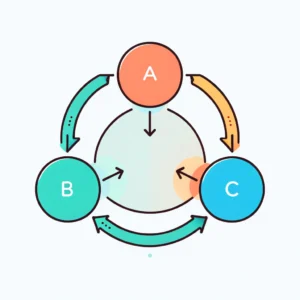What is Generative AI?
Generative AI is an artificial intelligence technology that lets users create brand new content quickly from various inputs and prompts including text, images, sounds, data and more....

What is Generative AI?
Generative AI is an artificial intelligence technology that lets users create brand new content quickly from various inputs and prompts including text, images, sounds, data and more.
This advanced technology is driven by foundation models—large AI models designed to handle multiple tasks out-of-the-box. These models can perform functions like summarisation, question answering, and classification with minimal training, making them adaptable to specific needs with very little example data.
Generative AI enhances speed and efficiency, enabling businesses and individuals to save time and money by streamlining the content creation process. It also improves the consistency and quality of outputs by utilising data inputs and reducing human error.
Speed and efficiency are improved with generative AI. This permits businesses and individuals to save both time and money creating content much faster. It can also improve the output consistency by and utilising data inputs and reducing human error.
Generative AI Applications
Generative Artificial Intelligence has a wide range of applications across different business functions including marketing and software development. It can be used for content creation, social media, coding, and other uses.
Generative AI for Marketing
The AI technology can produce high-quality text, images, videos, and audio. This is particularly useful for industries such as marketing, entertainment, and advertising, where fresh and engaging content is continually in demand.
Generative AI can craft compelling copy for advertisements, social media posts, and email campaigns, all tailored to specific target audiences. It can create stunning visuals and videos that capture attention and convey messages effectively. Additionally, generative AI can produce unique audio content, including music and voiceovers, adding a professional touch to multimedia projects.
The ability of generative AI to rapidly produce diverse and high-quality content not only saves time and resources but also allows marketers to experiment with different creative approaches, optimising their strategies for better results.
Generative AI in Software Development
Software developers can use generative AI for a wide range of tasks. This includes writing code, automate repetitive programming tasks, and even debugging software. This automation accelerates the software development process, which can save time, money and resources.
Generative AI for Social Media
AI is already used for Social Media creation and management. Geberative AI can create personalised Social Media posts, captions, and entire articles tailored to specific audiences, enhancing engagement and outreach efforts.
The History of Generative AI
Despite the recent hype surrounding technologies like ChatGPT, generative AI is not a new concept. It has been built on over 50 years of research and computational advances.
The Markov Chain

An early example is the Markov chain, which was introduced by Russian mathematician Andrey Markov in 1906. The Markov chain models the behaviour of random processes. In machine learning, Markov models have long been used for tasks like next-word prediction in text. However, these models are limited by their simplicity and short memory.
Complex Datasets
The real leap in generative AI comes from the increased complexity and scale of modern generative AI models. Researchers now use vast datasets, which sometimes contain billions of data points to train models that achieve impressive results.
ChatGPT

For example, ChatGPT is based on the transformer architecture, which was introduced by Google in 2017. It uses billions of parameters and a massive corpus of publicly available text from the internet. This enables it to understand and generate human-like text by learning patterns and dependencies in language.
Faster Content Creation
One of the key benefits of generative AI is its ability to create content much faster than traditional methods. For example, generating a complex image or writing an in-depth article that might take a human hours or even days can be accomplished by generative AI in a matter of minutes. This increased speed and efficiency not only saves time but also reduces the costs associated with content creation.
Benefits of Generative AI for Content Creation
The primary benefits of generative AI include rapid production, as it can produce high-quality content at a fraction of the time that it would take a human. This increases productivity and allows for quicker turnaround times on projects. By automating content creation, businesses can significantly cut down on labour costs and allocate resources more effectively.
Generative AI also ensures consistent output quality. This reduces the variability that can occur with human-created content. Moreover, the ability to quickly generate new and diverse content encourages experimentation and innovation, leading to the development of new ideas and solutions.
In summary, generative AI represents a transformative tool that enhances productivity and creativity across various fields, making it an invaluable asset in today’s fast-paced digital world.
How Does Generative AI Work?
Gen AI models use neural networks to find patterns in data to generate new content.
Neural networks consist of layers of interconnected nodes, or neurons, each of which processes a portion of the input data. When data is fed into a neural network, it passes through multiple layers. Each layer performs specific calculations to detect patterns and features in the data. This process is known as training. It involves adjusting the connections between neurons based on the input data and the desired output. Over time, the network learns to recognise complex patterns and generate outputs that closely resemble the training data.
Unsupervised Learning
Generative AI models often leverage learning methods like unsupervised learning, where the system is trained on large amounts of unlabelled data. This approach allows the model to identify underlying structures and relationships within the data without the need for explicit instructions. Unsupervised learning is particularly useful for creating versatile foundation models like GPT-4 and Stable Diffusion, which can generate a wide range of content from text to images.
In essence, generative AI models learn by example. By analysing vast datasets, they can generate new and diverse content that aligns with the patterns and characteristics of the input data. This ability to learn and create from large-scale data sets is what makes generative AI so powerful and versatile in various applications, from content creation to scientific research.
Generative AI Models
There are several types of generative AI models, each with unique mechanisms. These include:
1. Diffusion Models
Diffusion models use a two-step noise reduction process to generate high-quality data. The training involves adding noise to the data and then reversing this process to produce clean outputs.
For example, consider the task of generating high-resolution images. During training, a diffusion model takes a clear image and gradually adds noise until it becomes unrecognisable. Then, it learns to reverse this process, effectively removing the noise and reconstructing the original image. This iterative refinement allows diffusion models to produce highly detailed and realistic images. An example of this in action is the Stable Diffusion model, which can generate high-quality images from textual descriptions.
2. Variational Autoencoders (VAEs)
These models compress and reconstruct data using two main components: an encoder and a decoder. The encoder compresses the input data into a smaller, latent space representation, while the decoder reconstructs the data from this compressed form. This process is efficient but often results in less detailed outputs compared to other models. For instance, VAEs are commonly used to generate handwritten digits. They take a large set of handwritten digit images. They compress each image to a lower-dimensional representation, and then reconstruct the images. Although the outputs might not be as sharp as the originals, VAEs are valuable for generating new, diverse samples of handwritten digits that resemble the training data.
3. Generative Adversarial Networks (GANs)
GANs consist of two neural networks, which are the generator and the discriminator. They work in tandem to produce realistic data. The generator creates data such as images, while the discriminator evaluates them against real data and provides feedback to the generator. This adversarial process helps the generator improve over time.
For example, a GAN can be trained to generate realistic human faces. The generator produces images of faces, while the discriminator tries to distinguish between real photos and those generated by the model. As the generator receives feedback from the discriminator, it learns to create more lifelike faces. A well-known example of this is the StyleGAN, which can produce highly realistic human faces that are indistinguishable from real photos.
How to Develop Generative AI Models?
Developing generative AI models involves combining the strengths of different model types to create effective and efficient systems. Here’s a simple explanation of how this process works:
1. Diffusion Models
These models are excellent at producing high-quality outputs by managing noise. The process involves two main steps: adding noise to the data and then removing the noise. Adding noise means introducing random variations or disturbances to the data, which makes it less clear and more random. The model then learns to reverse this process by gradually removing the noise and refining the data back to its original, high-quality form. Although this method can be slow due to its detailed nature, it results in very sharp and realistic outputs.
For example, diffusion models are great for generating clear, high-resolution images from noisy, blurry ones.
2. Variational Autoencoders (VAEs)
VAEs are efficient at compressing and reconstructing data. They use an encoder to compress the input data into a simpler form and a decoder to reconstruct it. This process allows for quick data generation, though the results may be less detailed compared to other methods. VAEs are useful when you need to generate data rapidly, like creating a large number of basic synthetic images for testing.
3. Generative Adversarial Networks (GANs)
GANs consist of two networks. These networks are a generator that creates data, and a discriminator that evaluates it. The generator tries to produce data that the discriminator will think is real, improving over time with feedback. GANs can generate realistic data quickly, making them ideal for applications where speed is important, such as creating lifelike avatars or virtual environments.
What are the Applications of Generative AI?
Generative AI is useful in many fields with a wide range of applications including:
- Language: Creating text, code, and translations. Generative AI can write articles, generate code, and translate languages accurately and quickly.
- Audio: Developing music, speech, and sound effects. AI can compose original music, generate realistic voiceovers, and create unique sound effects.
- Visual: Producing images, 3D models, and videos. AI can create high-quality images, design 3D models, and generate videos with realistic special effects.
- Synthetic Data: Generating data to train other AI models. This is crucial for creating datasets for training models in scenarios where real data is scarce or sensitive, such as in medical research or autonomous vehicle testing.
Industries Utilising Generative AI
Generative AI applications can be applied to various fields and industries including:
- Healthcare: Assists in drug discovery by creating new molecular structures, improves medical imaging by enhancing image quality and automating analysis, and automates administrative tasks like medical scribing and coding.
- Automotive: Creates realistic 3D simulations for testing autonomous vehicles, reducing the need for physical prototypes, and generates synthetic data to train AI models for vehicle safety and performance.
- Entertainment: Transforms content creation by generating realistic CGI for movies, creating immersive environments for video games, and developing virtual reality experiences. AI can also compose music and design visual art.
- Marketing: Personalises advertising content, creating targeted ads based on user preferences and behaviour. It automates the creation of marketing materials like banners, social media posts, and product descriptions.
- Finance: Improves fraud detection by generating synthetic transaction data to train models, helps create financial reports, predict market trends, and develop personalised financial advice for customers.
- Retail: Enhances product design by generating new clothing or accessory designs, creates realistic virtual fitting rooms, and generates personalised shopping experiences and recommendations.
- Manufacturing: Optimises product design and manufacturing processes by creating new product prototypes, predicting maintenance needs for machinery, and generating efficient production schedules.
- Education: Develops personalised learning materials, creating quizzes, tutorials, and educational content tailored to individual student needs, and generates realistic virtual labs and simulations for hands-on learning experiences.
Generative AI’s versatility and capability to produce high-quality, diverse outputs make it an invaluable tool across various fields and industries, enhancing productivity, creativity, and efficiency.
What are the Challenges of Generative AI?
There are a number of challenges associated with generative AI for both general users and businesses. These include:
- Compute Infrastructure: Requires significant resources and expertise to manage large-scale models. The cost of high-performance hardware and cloud computing resources can be substantial, making it difficult for smaller organisations to implement generative AI solutions.
- Sampling Speed: Generating data quickly can be difficult, affecting applications needing instant responses. Slow sampling speeds can limit the real-time usability of generative AI in areas such as live customer service, automated trading, or interactive entertainment.
- Data Quality: Needs high-quality, unbiased data, which can be hard to source. Poor quality or biased data can lead to inaccurate or unethical AI outputs, impacting the reliability and fairness of the generated content.
- Data Licenses: Obtaining and maintaining data licenses can be challenging and costly. Access to proprietary datasets often involves legal complexities and significant expenses, which can be a barrier for research and development.
Understanding and addressing these challenges is crucial for the effective and ethical deployment of generative AI technologies across various industries.
What are the Benefits of Generative AI?
Integrating Generative AI into business practices can significantly boost your bottom line and overall operations. The benefits of Generative AI include:
- Efficiency: Generative AI significantly enhances the accuracy and efficiency of AI systems like natural language processing (NLP) and computer vision by generating synthetic data for training and evaluation. This synthetic data can be used to train models more quickly and effectively, reducing the time and resources needed to develop high-performing AI systems.
- Data Analysis: Generative AI helps explore and analyse complex data, uncovering hidden patterns and trends that may not be apparent from raw data alone. By generating new data that mirrors the underlying structure of the original dataset, AI models can gain deeper insights, leading to more informed decision-making in fields such as finance, healthcare, and marketing.
- Automation: Generative AI automates and speeds up various tasks and processes, saving time and resources for businesses and organisations. For example, AI can automate content creation, coding, data entry, and customer service interactions, allowing human workers to focus on more strategic and creative tasks.
- Innovation: Generative AI enables the creation of new applications and services by pushing the boundaries of what is possible. This includes creating realistic virtual worlds for simulations, advanced drug discovery methods, and personalised education tools. The ability to generate novel and high-quality content fosters innovation and opens up new possibilities in technology and business.
- Adaptability: Generative AI supports a wide range of industries, from healthcare to automotive, by improving processes and outcomes with innovative solutions. In healthcare, AI can generate synthetic medical data for training diagnostic models, design new molecules for drug discovery, and personalise patient care. In the automotive industry, AI can create realistic simulations for testing autonomous vehicles, enhance design processes, and optimise production schedules.
Gemmo AI Generative AI Clients
Gemmo AI work with clients to develop generative AI solutions to improve their business operations in a range of industries including finance and healthcare.
- Finance: In finance, Generative AI is used to enhance security, streamline operations, and offer valuable insights for better financial management. At Gemmo AI, we leverage Generative AI to revolutionise the finance industry. Our models improve fraud detection by generating synthetic transaction data, training systems to identify fraudulent activities more accurately. We also automate the creation of financial reports, quickly compiling clear and accurate summaries from vast amounts of data. Additionally, our tools use Generative AI to predict market trends and provide personalised financial advice, helping customers make informed decisions.
- Healthcare: Generative AI has transformative applications in healthcare, enhancing various aspects of medical research and patient care. At Gemmo AI, we train AI models in biochemistry to streamline the drug discovery process by generating new molecular structures. Our AI systems also improve medical imaging by enhancing image quality and automating image analysis, which aids in more accurate diagnoses. Additionally, we use AI to automate administrative tasks such as medical scribing and coding, allowing healthcare professionals to focus more on patient care. By leveraging Generative AI, we aim to make healthcare more efficient, accurate, and innovative
- Automotive: In the automotive industry, Generative AI revolutionises the testing and development of autonomous vehicles by creating realistic 3D simulations, significantly reducing the reliance on physical prototypes. It also generates synthetic data to train AI models, enhancing vehicle safety and performance.
- Entertainment: Generative AI transforms content creation in the entertainment sector. It produces realistic CGI for movies, crafts immersive environments for video games, and aids in the development of virtual reality experiences. Additionally, AI can compose music and design visual art, pushing the boundaries of creativity.
- Marketing: In marketing, Generative AI personalises advertising content by creating targeted ads based on user preferences and behaviour. It automates the production of marketing materials such as banners, social media posts, and product descriptions, thereby increasing efficiency and effectiveness. At Gemmo, we automate marketing processes using data analytics for deeper insights.
- Retail: Generative AI enhances product design in retail by generating new clothing and accessory designs. It creates realistic virtual fitting rooms, enabling customers to visualise products before purchase. AI also tailors shopping experiences and recommendations to individual customers.
- Manufacturing: Generative AI optimises product design and manufacturing processes. It creates innovative product prototypes, predicts maintenance needs for machinery, and develops efficient production schedules, ultimately reducing costs and boosting productivity. At Gemmo AI, we harness computer vision to ensure consistency on the production line.
- Education: Generative AI tailors educational materials to individual student needs, creating quizzes, tutorials, and other content. It also generates realistic virtual labs and simulations, providing hands-on learning experiences that enhance understanding and engagement.



